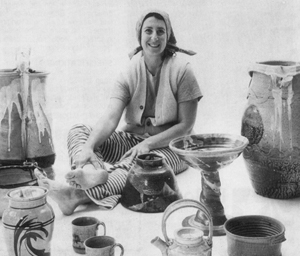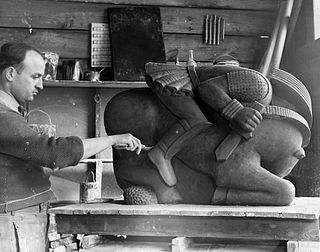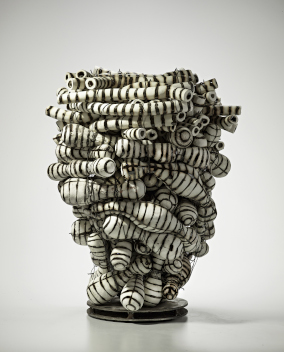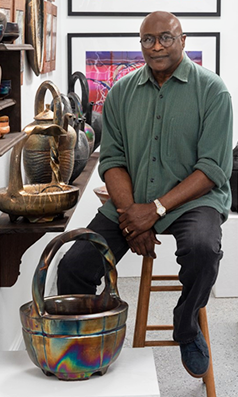
Peter Voulkos was an American artist of Greek descent. He is known for his abstract expressionist ceramic sculptures, which crossed the traditional divide between ceramic crafts and fine art. He established the ceramics department at the Los Angeles County Art Institute and at UC Berkeley.
Richard E. DeVore, also written as Richard De Vore was an American ceramicist, professor. He was known for stoneware. He was faculty at Cranbrook Academy of Art’s Ceramics Department, from 1966 to 1978.
Toshiko Takaezu was an American ceramic artist, painter, sculptor, and educator whose oeuvre spanned a wide range of mediums, including ceramics, weavings, bronzes, and paintings. She is noted for her pioneering work in ceramics and has played an important role in the international revival of interest in the ceramic arts. Takaezu was known for her rounded, closed ceramic forms which broke from traditions of clay as a medium for functional objects. Instead she explored clay's potential for aesthetic expression, taking on Abstract Expressionist concepts in a manner that places her work in the realm of postwar abstractionism. She is of Japanese descent and from Pepeeko, Hawaii.

Elizabeth Woodman was an American ceramic artist.
John Mason was an American artist who did experimental work with ceramics. Mason's work focused on exploring the physical properties of clay and its "extreme plasticity". One of a group of artists who had studied under the pioneering ceramicist Peter Voulkos, he created wall reliefs and expressionistic sculptures, often on a monumental scale.
Regis Brodie is a tenured Professor of Art at the Department of Art and Art History at Skidmore College in Saratoga Springs, NY and a potter. Since 1972, he has been serving as the Director of the Summer Six Art Program at Skidmore College. He also wrote a book called The Energy Efficient Potter which was published by Watson-Guptill Publications in 1982. He started the Brodie Company in 1999 in the interest of developing tools which would aid the potter at the potter's wheel.

Kenneth Price was an American artist who predominantly created ceramic sculpture. He studied at the Chouinard Art Institute and Otis Art Institute in Los Angeles, before receiving his BFA degree from the University of Southern California in 1956. He continued his studies at Chouinard Art Institute in 1957 and received an MFA degree from New York State College of Ceramics at Alfred University in 1959. Kenneth Price studied ceramics with Peter Voulkos at Otis and was awarded a Tamarind Fellowship.

Arnold Zimmerman (1954-2021), also known as Arnie Zimmerman, was an American sculptor and ceramic artist. His work ranged from monumental to miniature, and abstract to figurative, encompassing totemic vessel forms, tabletop sculpture and figures, murals, and room-size installations. He was part of a multi-decade, 20th-century shift in American ceramics during which artists challenged clay's identification with function and craft, engaging fine-art domains such as emotional expression, social commentary, figuration and narrative. Zimmerman first gained recognition in the 1980s for deeply carved, architectonic sculptures characterized by rough physicality, rhythmic surfaces, gestural presence and Italian Romanesque influences. In the mid-1990s, he shifted to figurative work that critic Donald Kuspit wrote, examined the interaction of finite man and infinite matter, artist and creative work: "There is a sense of futility and folly as well as seemingly senseless idealism and innocence built into Zimmerman's parables of the all-too-human."

Waylande Desantis Gregory was one of the most innovative and prolific American art-deco ceramics sculptors of the early 20th century. His groundbreaking techniques enabled him to create monumental ceramic sculpture, such as the Fountain of the Atoms and Light Dispelling Darkness, which had hitherto not been possible. He also developed revolutionary glazing and processing methods, and was a seminal figure in the studio glass movement.

Annabeth Rosen is an American sculptor best known for abstract ceramic works, as well as drawings. She is considered part of a second generation of Bay Area ceramic artists after the California Clay Movement, who have challenged ceramic traditions involving expression, form and function and helped spur the medium's acceptance in mainstream contemporary sculpture. Rosen's sculptures range from monumental to tabletop-sized, and emerge out of an accumulative bricolage process combining dozens or hundreds of fabricated parts and clay fragments and discards. Reviewers characterize her art as deliberately raw, both muscular and unapologetic feminine, and highly abstract yet widely referential in its suggestions of humanoid, botanical, aquatic, artificial, even science-fictional qualities. Critic Kay Whitney wrote that her work is "visceral in its impact, violent even, but also sensual and evocative" and "floats between the poles of the comic and the mordant."

James C. Watkins was born in Louisville, Kentucky, in 1951 and raised in a farming family in Athens, Alabama. He is a ceramic artist living in Lubbock, Texas who has worked with clay for over 40 years. He is known for his large scale double-walled ceramic vessels and laser cut porcelain substrate tiles. He is recognized for his textured surfaces, created by using alternative firing techniques. His porcelain substrate tiles are fumedArchived 2014-09-07 at the Wayback Machine with stannous chloride and multi-fired using ferric chloride, gold and platinum luster to achieve colorful surfaces.
Kirk Mangus (1952–2013) was an internationally renowned ceramic artist and sculptor "known for his playful, gestural style, roughhewn forms, and experimental glazing". His murals, works in clay, on paper, in wood, and other media pull from a rich and diverse set of influences: ancient Greco-Roman art, mythology, Japanese woodblock prints, comic books, folk stories, from Meso-American through Middle-Eastern and Asian ceramic traditions as well as the people he saw, the places he travelled, and his own dreamworld. He loved experimenting with new mediums, local materials, clay bodies, slips, kiln-building and the firing process.
Jack Earl is an American ceramic artist and former teacher, known for drawing inspiration from his home state of Ohio to create rural pieces “with meticulous craftsmanship and astute details… to where you could smell the air, hear the silence and swat the flies.” Although his works hint at highly personal, intellectual, and narrative themes in an almost unsettling manner, Earl is “a self-described anti-intellectual who shuns the art world." He is known particularly for using his trademark format, the dos-a-dos : “This art form is like a book with two stories… the two seemingly incongruent images prompt the viewer to fill in the conceptual gap through poetic speculation.” His work often involves dogs or the character “Bill”, who is said to be a combination of Earl’s father-in-law, himself, and others. The titles to his pieces are typically lengthy, stream-of-consciousness narratives that suggest the folk or rural lifestyle. These are intended to add another dimension to the artwork. His work has received a notable response over his decades-long career, especially since he is regarded as “a master at reminding us that within the events we take for granted are moments of never-ending mystery and wonder.” Earl continues to live in Lakeview, Ohio with his wife, Fairlie.
Richard Shaw is an American ceramicist and professor known for his trompe-l'œil style. A term often associated with paintings, referring to the illusion that a two-dimensional surface is three-dimensional. In Shaw's work, it refers to his replication of everyday objects in porcelain. He then glazes these components and groups them in unexpected and even jarring combinations. Interested in how objects can reflect a person or identity, Shaw poses questions regarding the relationship between appearances and reality.
Chris Gustin is an American ceramicist. Gustin models his work on the human form, which is shown through the shape, color, and size of the pieces.
Tip Toland is an American ceramic artist and teacher who was born in Pottstown, Pennsylvania. She earned a BFA in Ceramics from the University of Colorado and an MFA in Ceramics from Montana State University. Her works, which are figurative and often described as "hyper-real," are held by galleries and museums around the United States.
Karl Martz was an American studio potter, ceramic artist, and teacher whose work achieved national and international recognition.

Nancy Selvin is an American sculptor, recognized for ceramic works and tableaux that explore the vessel form and balance an interplay of materials, minimal forms, and expressive processes. She emerged in the late 1960s among a "second generation" of Bay Area ceramic artists who followed the California Clay Movement and continued to challenge ceramic traditions involving expression, form and function, and an art-world that placed the medium outside its established hierarchy. Her work has been exhibited at the Los Angeles County Museum of Art (LACMA), Denver Art Museum, Daum Museum of Contemporary Art and Kohler Arts Center, and belongs to the public art collections of LACMA, the Smithsonian Institution, Oakland Museum of California, and Crocker Art Museum, among others. Critic David Roth has written, "Selvin's position in the top rank of ceramic artists has come through a process of rigorous self-examination … what differentiates [her] is that she eschews realism and functionality, indicating a level of intellectual engagement not always found among ceramicists." Writer and curator Jo Lauria described Selvin's tableaux as "elegiac and stylistically unified" works that serve as "forceful essays on the relationship between realism and abstraction, object and subject, decoration and use." Selvin lives and works in the Berkeley, California area.

Jun Nishida was a Japanese ceramicist. He is best known for his massive conceptual pottery pieces, which experiment with the material capacities of clay and the imaginative forms that ceramics could take amid the intense thermochemical conditions of the kiln. Throughout his brief yet productive career, Nishida pushed the boundaries of contemporary ceramics, challenging conventions of scale, abstraction, and method to produce a radically new visual language of pottery.

Paul Chaleff is an American ceramist and professor emeritus of Fine Arts at Hofstra University. He is considered a pioneer of the revival of wood-fired ceramics in the US and credited as one of the first to use wood-burning dragon kilns in the style of the anagama tradition. He is best known as an innovator of large-scale ceramic sculpture. His work can be found in the collections of the Museum of Modern Art Department of Architecture and Design, and in the Metropolitan Museum of Art.










